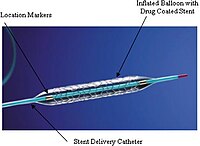
Photo from wikipedia
Background Diabetes is associated with adverse outcomes after percutaneous coronary intervention with drug-eluting stents (DES), but for prediabetes this association has not been definitely established. Furthermore, in patients with prediabetes… Click to show full abstract
Background Diabetes is associated with adverse outcomes after percutaneous coronary intervention with drug-eluting stents (DES), but for prediabetes this association has not been definitely established. Furthermore, in patients with prediabetes treated with contemporary stents, bleeding data are lacking. We assessed 3-year ischemic and bleeding outcomes following treatment with new-generation DES in patients with prediabetes and diabetes as compared to normoglycemia. Methods For this post-hoc analysis, we pooled patient-level data of the BIO-RESORT and BIONYX stent trials which both stratified for diabetes at randomization. Both trials were multicenter studies performed in tertiary cardiac centers. Study participants were patients of whom glycemic state was known based on hemoglobin A1c, fasting plasma glucose, or medically treated diabetes. Three-year follow-up was available in 4212/4330 (97.3 %) patients. The main endpoint was target vessel failure, a composite of cardiac death, target vessel myocardial infarction, or target vessel revascularization. Results Baseline cardiovascular risk profiles were progressively abnormal in patients with normoglycemia, prediabetes, and diabetes. The main endpoint occurred in 54/489 patients with prediabetes (11.2 %) and 197/1488 with diabetes (13.7 %), as compared to 142/2,353 with normoglycemia (6.1 %) (HR: 1.89, 95 %-CI 1.38–2.58, p < 0.001, and HR: 2.30, 95 %-CI 1.85–2.86, p < 0.001, respectively). In patients with prediabetes, cardiac death and target vessel revascularization rates were significantly higher (HR: 2.81, 95 %-CI 1.49–5.30, p = 0.001, and HR: 1.92, 95 %-CI 1.29–2.87, p = 0.001), and in patients with diabetes all individual components of the main endpoint were significantly higher than in patients with normoglycemia (all p ≤ 0.001). Results were consistent after adjustment for confounders. Major bleeding rates were significantly higher in patients with prediabetes and diabetes, as compared to normoglycemia (3.9 % and 4.1 % vs. 2.3 %; HR:1.73, 95 %-CI 1.03–2.92, p = 0.040, and HR:1.78, 95 %-CI 1.23–2.57, p = 0.002). However, after adjustment for confounders, differences were no longer significant. Conclusions Not only patients with diabetes but also patients with prediabetes represent a high-risk population. After treatment with new-generation DES, both patient groups had higher risks of ischemic and bleeding events. Differences in major bleeding were mainly attributable to dissimilarities in baseline characteristics. Routine assessment of glycemic state may help to identify patients with prediabetes for intensified management of cardiovascular risk factors. Trial registration : BIO-RESORT ClinicalTrials.gov: NCT01674803, registered 29-08-2012; BIONYX ClinicalTrials.gov: NCT02508714, registered 27-7-2015.
Journal Title: Cardiovascular Diabetology
Year Published: 2021
Link to full text (if available)
Share on Social Media: Sign Up to like & get
recommendations!